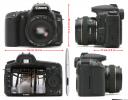On the frontline of new cameras for the digital SLR market, the Internet forums are agitated -again- with rumours and news quite surprising.
There was the publication of alleged photos of the Canon EOS 40D on a Korean web site (see below). The work of the graphic artist is quite sloppy (the 4 of the logo on the front of the camera is not correctly aligned with the rest and with the 0 of 40D ; The LCD on the back was stuck on the image without cheking the integration into the rest of the design : different colors for the plastic and parts are links quite quickly with little consideration for the manufacturability).

It’s less funnny than the nice work of Samuele Silva dreaming about the 40D.
But now comes that alleged Olympus document, supposedly intended to document the future E-P1 camera for the Olympus sales people and to provide comparison with its direct competition.

Here, we have a very complete PDF document. Parts of it are still availble here and there on the DPReview forums about the Olympus E-P1. The most interesting is certainly the table seen above. First, it is quite difficult to tell if the file is really authentic (if it really comes from Olympus). Then, even if authentic, it may not contain secret revelations Olympus got about its competition (personally, I tend to believe that if a company like Olympus had stolen such information, it would try to keep them near the body to avoid dirty legal consequences : sales people and marketing guys are notoriously bad at keeping secrets in any large company). Last but not least, it would be very surprising that data for two significant competitors such as the Canon 40D and the Nikon D300 would be of the same quality/precision.
In my humble opinion (but it is also the opinion I prefer to refer myself in most cases), it could well be reference data used internally by Olympus and based upon a mix of rumours heard here and there, and realistic projections that the marketing department must maintain in order to intelligently anticipate moves of other camera brands. Not even counting in the added publicity that Olympus gets for the E-P1 from people anxious to see news from the Canon 40D and Nikon D300.
Keeping these position and point of view, you can nevertheless read very interesting information from this table:
- A very probable resolution increase (12MP for Nikon and Canon)
- Olympus does not believe that either Nikon or Canon would abandon in-lens image stabilisation (adding an in-body stabilisation would blur the message to the public and could break the historical advantage of both brands). But Olympus sticks to the in-body solution that has been so positive for brands that could not easily close the lateness in adding IS in a full lens line.
- Nikon will stay with its exceptionally good Auto-Exposure (CCD with 1000+ pixels -for a long time now) but Olympus decide to keep the pace (49 zones on the E-P1).
- As we know it, reaction speed is no longer a real issue for modern SLR cameras, but the race is not finished yet with measurable (if not perceptible) differences between the three cameras.
- 5 frames per second is fast becoming the standard in high-end digital SLR cameras (I find it intersting how many forum talks are about whether 3fps or 5fps are enough for sports photo and how few are about the advantages of blindlingly fast shutter speeds).
- Olympus chose to have the best possible AutoFocus on the E-P1: The fastest and using 11 sensors (it will be interesting to see this in reality since this issue can be critical for fast shooting and sports)
- The viewfinders fields are still a little limited in Nikon an dCanon, but Olympus decided to reac for an excellent 100%
- VEry astonishing: the precision of information about the size of the LCD screen on the back. We know that the trend is to improve confort of the photographer with larger screens, but a Nikon D300 with a 3-inch LCD would be impressive and unpleasant to Olympus and Canon. However, this would present a serious ergonomic risk since the larger the screen, the less space left for fingers and buttons, if the camera body is not bulky…
- Then comes the body protection leaving only the Canon 40D as not splash-proof. You don’t have to work in Canon to understand that this is not their first priority : Even the outrageously expensive Canon 5D has only minimal protection. But the Nikon D300 has to follow in the footesteps of the D200 where it was already welcomed and while the Pentax 10D brought splash-proof designs to a price level never seen before.
- Being positive on the fact that the Canon 40D will include dust-remoal on the sensor does not require extra-sensorial powers since the technology is already here on the 400D/Xti. Nikon still uncertain about this? You bet! Olympus has no doubt for a long time since they even have the best technology on the market (ultrasonic vibration of the sensor).
- In the end, the presence of LiveView (or continuous display on the back of the camera) that requires a sensor low on power consumption and efficient on cooling is probably reachable for Canon, where Nikon (and Sony, their sensors provider for high-end cameras) seems not to be willing to epxlore the field yet.
I let you judge byb yourself, but everything shows that Fall will be very agitated (some even say that July could be the month of shockingly new announcements, but this is not the first time we heard this, is’nt it?).
Main source: Northlight Images.

Leave a Reply